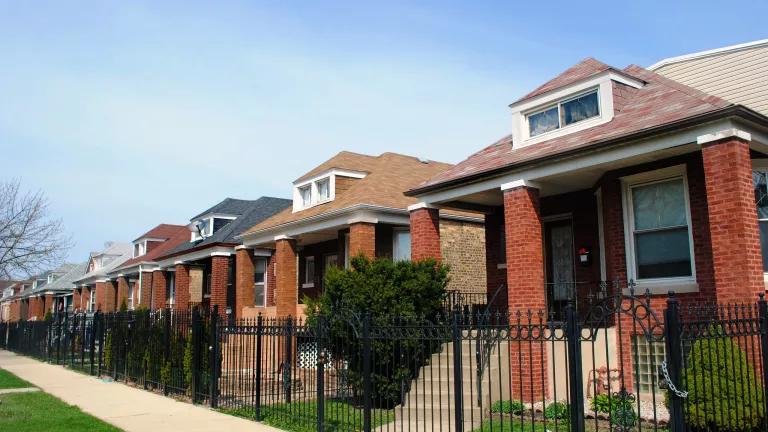California Moves Toward Smart and Efficient Water Heating
California has just adopted an energy code specification for grid-friendly and super-efficient water heaters that will help decarbonize buildings and the electric grid while saving Californians money on their utility bills.

California has just adopted an energy code specification for grid-friendly and super-efficient water heaters that will help decarbonize buildings and the electric grid while saving Californians money on their utility bills.
The California Energy Commission (CEC) voted unanimously today to adopt a new appendix to the state’s building energy code, called “Joint Appendix 13” (JA13), that will enable the code to reward smart electric heat pump water heaters (HPWH) for their grid benefits. Its development was facilitated by NRDC, in collaboration with a large group of water heater manufacturers, utilities, other industry stakeholders, non-profit organizations, and the CEC over the past two years.
Practically, builders who install these grid-friendly and highly-efficient HPWHs in new homes will get a compliance credit that will make it easier for them to meet the code’s energy-saving target, providing more flexibility to reduce overall construction costs.
Heating water for showers and other domestic uses with gas water heaters is the largest use of energy and biggest source of pollution in the average California home before space heating. Electric HPWHs are a game-changer for cutting home pollution because they use just one-third to one-fifth of the energy of conventional water heaters, and can be powered by clean renewable electricity, producing zero pollution both on-site and on the electric grid. Eliminating gas combustion in homes reduces both climate and harmful air pollution in homes and outdoors. Heat pump water heaters can turn domestic water heating into an asset that will help us transition to cleaner air, lower utility bills, and a safer climate.
Heat Pump Water Heaters as Clean Energy Batteries
But HPWHs also have another benefit that has long been untapped: they can double as clean-energy batteries by essentially storing water heated by emissions-free solar energy for use during times when the sun isn’t shining.
Every one of California’s 14 million homes needs a water heater, and many businesses have one too. Most of these water heaters are individual units serving a single home. Others use central systems serving an entire apartment building. By turning the millions of individual and central water heaters into efficient and flexible batteries, California can store water heated by its solar and wind energy when it is abundant, for use when people and businesses need it later, without adding load to the grid at times when demand is high and fossil fuel power plants are still needed to serve peak power needs. Demand-flexible HPWHs can respond to either time-of-use utility rates or to grid signals from the utility to optimize when they operate, minimizing bills automatically without user action.
Doing so over millions of water heaters will reduce the cost of operating California’s electric grid, limiting the need to use expensive power plants to meet customer energy needs while maximizing the use of solar and wind energy that have zero fuel costs. This means California’s grid and renewable energy resources will be used more effectively, putting downward pressure on electric rates and saving every Californian money.
Efficient and Flexible Electrification
The CEC has identified that converting California’s buildings from using gas for water and space heating to clean and renewable electricity is the lowest-cost and lowest-risk pathway to “decarbonizing” buildings, i.e., eliminating health and climate pollution from burning fossil fuels in water heaters and furnaces. However, energy efficiency and demand flexibility are also essential components of cost-effective decarbonization, to keep utility bills low for occupants of all-electric buildings and reduce electric grid costs for all Californians. Flexible HPWHs hit all three criteria: they are super-efficient, they can be flexible when complying with this new JA13 specification, and they can be powered entirely by clean renewable energy when operating at the right time of the day.
Why this New Specification Matters
No matter how important HPWHs are to California’s clean energy future, the significance of this new specification goes well beyond the water heating appliance: as the largest use of gas in homes, water heaters are a gateway to home electrification. Once a builder switches to an electric heat pump water heater, there is little reason to install a gas furnace when a heat pump can provide heating and cooling at a lower cost.
By valuing the grid benefits of HPWH and opening up a new value stream for this technology, this new specification will accelerate the transition toward the all-electric, highly-efficient construction that will help clean up California’s air and safeguard a safer climate future.
Thirty cities and counties across California have already adopted local policies that encourage or require all-electric new construction. Now the CEC has the opportunity to follow suit and extend these local policies to the entire state, setting a uniform standard across California.
Joint Appendix 13 and other similar policies provide more flexibility to builders, allowing them to build faster and cheaper, all while cutting fossil fuel pollution. At a time when the Golden State’s housing costs are sky-high and the economy is reeling from the COVID-19 pandemic, reducing building costs is essential to help meet Governor Newsom’s goal of ramping up new home construction and putting Californians back to work in the construction sector.
Other policies necessary to encourage adoption of these highly-efficient water heaters include providing financial incentives to make the transition more affordable for customers, just like incentives from the California Solar Initiative program successfully transformed the market for rooftop solar and created a thriving solar installation industry that employs many Californians today.
What this Means for Residents
Users of grid-responsive HPWHs won’t notice a thing at the shower or faucet: they will get the same piping hot water they are accustomed to. But they will see a difference on their monthly bills, especially when on a “time-of-use” electric rate that varies electricity prices by time of day. For example, Southern California Edison’s TOU-D-PRIME electric rate varies from 38 cents per kilowatt-hour from 4 p.m. to 9 p.m. on summer weekdays, to only 13 cents per kilowatt-hour the rest of the day. Smart HPWHs will automatically avoid drawing power during expensive times, and charge up during cheap times instead, without users being aware of it.
While the CEC’s decision applies only to new construction initially, the California’s Public Utilities Commission is developing a program under the Self Generation Incentive Program (SGIP) to provide financial incentives for these smart HPWHs in existing buildings too. NRDC and a broad coalition of environmental organizations and manufacturers proposed a program design that would leverage CEC’s Joint Appendix 13 to determine which products are eligible for incentives.
To ensure that lower-income Californians also have access to these clean energy benefits including lower bills, the BUILD incentive program that is being developed by the CEC to encourage low-emissions new building construction reserves 75 percent of its $80 million to low-income customers, and we expect the SGIP program to also allocate a significant share of its budget toward low-income households. Smart HPWHs will no doubt be important pieces of both programs.
As with solar energy, and electric vehicles, the clean energy revolution is underway in California’s homes and businesses, and the CEC has just taken an important step to facilitate it by rewarding the grid benefits of smart and efficient heat pump water heaters.



